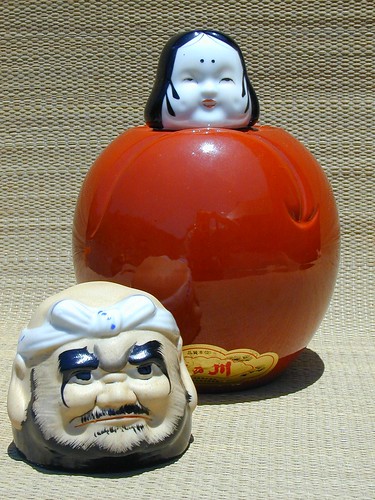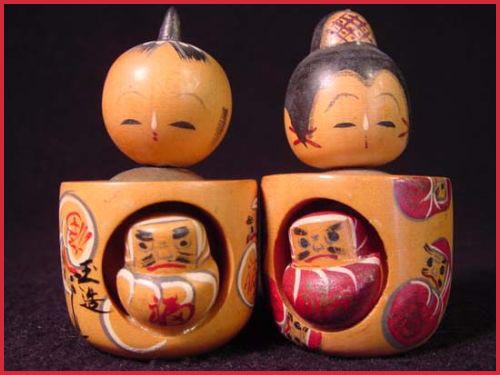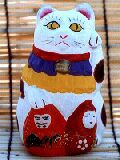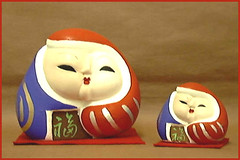:::::::::::::::::::::::::::::::::::::::::::::::::::::::::::::::::::::::::::::::::::::::::::::::::::::
Senkootate - Daruma as an Incense Stick Holder
線香立てとだるま ― 香道散歩
This topic comprises various parts:
Koo お香 Incense - Introduction
Koogoo - Daruma as an Incense Container 香合とだるま
Kooro - Daruma as an Incense Burner 香炉とだるま

:::::::::::::::::::::::::::::::::::::::::::::::::::::::::::::::::::::::::::::::::::::::::::::::::::::
Let us venture into the world of incense.
Sometimes I feel the private use of incense in a home is the origin of all modern aromatherapy. To light an incense stick and a candle after a hectic day of work, listen to some soft music and taste some nice ricewine is a treat for all of your senses. It lifts your spirit on a higer level in no time and lets you enjoy the moment as a human BE-ING, not DO-ING for a while.
Incense in Japan has been introduced together with Buddhism in the 5th century and been used during religious ceremonies for a long time. It seems to purify the holy space of a temple and pacify the mind of the worshippers to enable them to get a glimpse (should I say: a whiff) of the Beyond. But maybe only in Japan has the use of incense been elevated to the "Way of the Incense" (koodoo 香道), next to the Way of Tea, the Way of the Flowers, the Way of the Bow and so many other Japanes WAYs of enriching life with a sence of
the true, good and beautiful (shinzenbi 真善美).
During the Heian period the use of incense turned into an elaborate "Fragrance Hobby" (gankoo 翫香) which brings us to the novel of Genji (Genji Monogatari 源氏物語) by Murasaki Shikibu 紫式部.
Read about incense and poetry :
source : www.japanese-incense.com/
:::::::::::::::::::::::::::::::::::::::::::::::::::::::::::::::::::::::::::::::::::::::::::::::::::::

In "The Book of Incense"
Kiyoko Morita introduces you to this "refined, highly nuanced art form intimately related to classical Japanese poetry and prose and dedicated to an enhanced appreciation of the sences." If you are ready for a new experience of the senses, follow the many hints of this lovely little book. In the foreword by Professor Edwin Cranston from Harvard University we read: "As in all matters of cultural appreciation, one needs to enter into the spirit of the thing. The fragrance of smoldering aromatic woods, each subtly different, makes it easy to do just that. Fragrances remind us of home - the garden, the embrace of scented sleeves, the memory of one who has passed away - and in this resides their true power." Maybe you want to light an incense stick before reading on, just as I always light one before sitting down at the desk pondering my Daruma stories.
The smell of incense can be very subtle and faint, so the act of concentrated smelling it is called "listening to incense" (monkoo, bunkoo 聞香) in Japanese.
Here is one explanation for this expression.
In the Buddha's world everything is fragrant like incense, including the words of Buddha. Fragrance and incense are synonymous, and Buddha's words of teaching are incense. Therefore Bodhisattvas listen to Buddha's words in the form of incense, instead of smelling them.
Reference : The Book of Incense
:::::::::::::::::::::::::::::::::::::::::::::::::::::::::::::::::::::::::::::::::::::::::::::::::::::
Here is a quote form David Ollers HP about the practical use of incense sticks during Zazen practise.
"Commonly, most Buddhist teachers will say incense is not used as a psychotropic aid for meditation or religious practice, or a psychological-state altering vehicle to enlightenment. The vast majority of Buddhist monks would not prescribe incense for this purpose, and feel you should be able to meditate and achieve spiritual awakening regardless of the aromatic environment. Benefits the Zen monks may speak of are: incense helps keep the flies out of the Zendo, it prevents unwanted body odors from becoming a distraction, and that it is used as a clock or timer for sitting periods. And then they will tell you not to blink if a fly drinks the water from your eye, no odor should distract your meditation, and don't watch the clock since "Time is Being!"
http://www.japanese-incense.com/incense-sticks.htm
:::::::::::::::::::::::::::::::::::::::::::::::::::::::::::::::::::::::::::::::::::::::::::::::::::::

Different Kinds of Incense お香の種類
In an article by David Oller about incense making you find an introduction to many ingredients.
http://www.botanical.com/botanical/article/feature_articles/incense/incense.html
Nippon Koodoo (Nippon Kodo) 日本香道 also features some interesting information.
http://www.nipponkodo.co.jp/incense/material/index.html
Incense Ingredients
Breaking down the five elements and their Ayurvedic relationship to plants and common incense ingredients we find them falling into five classes. The following chart shows the relationship:
1. Ether (Fruits) Star Anise (daiuikyoo 大茴香)
2. Water (Stems & Branches)
Sandalwood (byakudan 白檀),
Aloeswood (jinkoo, jinko, chinkoo, jinsuikoo 沈香 kyara 伽羅),
Cedarwood, Cassia (Chinese cinnamon, keihi 桂皮),
Frankincense (Olibanum, nyuukoo 乳香),
Myrrh(motsuyaku), Borneol (Bornean Camphor "Dragon's Brain" 龍脳)
3. Earth (Roots)
Turmeric(Kurkuma, ukon ウコン), Ginger, Costus Root, Valerian,
Spikenard Indian (kanzoo 甘草)
4. Fire (flower) Clove(chooji 丁子)
5. Air (leaves) Patchouli (パチョリ、kakkoo カッコウ)
時代が中世に至って、香木の希少性は前代と変わらなかったものの、香料を混ぜて「薫物」として使うことにより衣服や装身具、日用品や家具に至るまで香を焚き込める風習が貴族社会の中で生まれ始めます。この頃から香木は、丁子(インドネシア産:フトモモ科の木の蕾)、麝香(チベット産:ジャコウジカの雄の性線)、乳香(エジプト産:ボスウェリア属の木の樹脂)、甲香(モザンビーク産:巻貝の貝殻)、龍脳(ボルネオ産:龍脳木の内部結晶)等とともに「練香(ねりこう)」としての文化を築き始めます。
http://plaza27.mbn.or.jp/~921/ganko/ganko.html
:::::::::::::::::::::::::::::::::::::::::::::::::::::::::::::::::::::::::::::::::::::::::::::::::::::
Kyara - Aloeswood (Agarwood)
in six different flavours from six different regions (rikkoku 六国)
Kyara is one of the most desired incense ingredients in the entire world! This amazing substance has affected individuals throughout history so powerfully that in many Asian languages the term "Kyara" has been used to signify the finest of things. The most beautiful women in Japan are called Kyara Ladies, meaning that their beauty is rare and the finest possible, Kyara Clogs meant high-quality clogs and so on.
The most famous piece of Kyara is called "Ranjatai" and kept in the imperial storehouse Shoosooin (Shosoin 正倉院) on the grounds of the temple Toodai-ji in Nara. The white bands show where chips have been cut off as presents to high-ranking people like Oda Nobunaga, Toyotomi Hideyoshi and the first Tokugawa Shoogun Ieyasu.
The other areas are Rakoku (羅国)、Manaka (真那賀), Manaban (真那蛮), Sumotara (寸門多羅) and Sasora (佐曽羅).
http://www.japanese-incense.com/aloeswood.htm
http://www.baieido.co.jp/okou/genryo.html
梅栄堂の日本語はこちら。
http://www.baieido.co.jp/
Sacred wood for incense
http://www.hikoshin.org/Incense/SACRED_WOODS/SACRED_WOOD_INDEX1.htm
:::::::::::::::::::::::::::::::::::::::::::::::::::::::::::::::::::::::::::::::::::::::::::::::::::::
Incense sticks, Joss sticks
(alternative spellings are senkoo, senko, senkou, senkoh 線香)
You get the best fragrance from a lit stick if you keep it 20 to 30 cm from your nose. The red spot where the stick is burning does not emit fragrance, rather it is the part of the stick a few milimeters below where the heat causes the fragrance to be released.
My favorite incense stick comes from the store Tenkun-Doo in Kamakura. It is the first on the list called 寿王.
私の大好きなお線香はこちらの寿王です。
http://www.tenkundo.co.jp/shop/body.html
In Japan we have some other interesting types of incense. I will introduce you to two of them.
Incense sticks with Sutras funkyookoo 焚経香
The Heart Sutra (Hanya Shinkyoo) or other sutras are written in tiny golden or silver Chinese characters on 20 incense sticks. The name of the temple where you get them is usually also written on them. The stick does not disintegrate during burning but keeps standing with the tiny letters of the sutra shining dark on the ashes. It is quite a treat to sit down quietly and watch one stick slowly turning into living ashes. If you look at the HP quoted below and touch the box of incense, you can see a picture of the stick after burning. These wonders of handycraft are made by Anshin-Doo 安心堂.
焚経香の形状は直径2.5ミリ×145の香を20本整列させたもので、二百六十六文字におよぶ般 若心経まで鮮明に表記されています。2.4ミリの文字は正常な視力の方ならはっきり判読できます。
焚経香を焚くと、煙が大気に溶けるように消えてなくなる様はあたかも目に見えないもの(神、仏、ご先祖、自分の信じるもの)に自分の気を届けてくれるようなイメージがあります。
http://www.osenko.com/funkyou.html
Incense Sticks with Buddha Image and Name
butsugenkoo 佛現香

These sticks are almost five milimeters in diameter and you need a big container to stand them firmly. They are completely black with a light spot on the top side. You put them in the container with the spot facing you and sit back in quiet meditation for about 30 minutes. After the stick has burned down about 5 milimeters without disintegrating, the face of Amida Buddha is starting to appear on the white ash stick. Then as it burns down further the Chinese characters for the incantation of Amida, Namu Amida Butsu, start to appear in dark color on the stick. As the gentle smell fills the room you can visualize the benevolence of the Buddha as you watch its name appear fully. One stick which I burned about a month ago is still standing firmly.
御仏のお姿と聖号が現れる線香です。阿弥陀さんのお顔と南無釈迦牟尼佛という文字がゆっくり線香の灰に現れます。線香を観察し香りを楽しみながらとても神秘的な30分をすごす不思議な、癒しの線香です。
:::::::::::::::::::::::::::::::::::::::::::::::::::::::::::::::::::::::::::::::::::::::::::::::::::::
photos TBA
Its time to look at some incense stick holders with Daruma.
Here is one made of Bizen pottery and sold at local stores in Bizen City. He is only 2 cm high but his eyebrows are strongly modelled and he seems to watch the incense stick while it burns.
こちらは今備前市で売っているミニ線香たてです。備前焼のだるまさんの眉が大きくて、線香が燃えるのを見張っているような顔つきです。
This little fellow is made of Arita pottery. He comes with a little tray of white and red color. His face is painted in blue and he holds his arms forward to take the incense stick almost as if it was a sword to fight. He is 3.5 cm high.
このかわいらしいだるまは有田焼でできています。腕をまえに伸ばして、まるで剣道を棒を持つように線香を持っています。
This one comes with a heavy white tray and is quite heavy himself. His face is simple but quite expressive. He is 3 cm high and made by Nippon Craft.
こちらのだるまを先週近くの高島屋で買いました。白いお皿はすごく重くて、だるまも重いです。とても簡単な顔つきで力強いです。
:::::::::::::::::::::::::::::::::::::::::::::::::::::::::::::::::::::::::::::::::::::::::::::::::::::

source : www.butgu.com/shop
:::::::::::::::::::::::::::::::::::::::::::::::::::::::::::::::::::::::::::::::::::::::::::::::::::::
I
bright summer morning
the musty smell of jinko
still clings to your hair.
though not completely awake
last night rushes back at me
II
Mid July morning
a soft grey mist everywhere
hill and sky obscured
for forty years, behind me
now at sixty, my destination
III
cannot find the moon
yet luminous clouds tell me
that it's still up there
It would seem there're two, moons that is,
one veiled, another in my heart
Patrick Duffey, facebook
:::::::::::::::::::::::::::::::::::::::::::::::::::::::::::::::::::::::::::::::::::::::::::::::::::
Koo お香 Incense - Introduction
Koogoo - Daruma as an Incense Container 香合とだるま
Kooro - Daruma as an Incense Burner 香炉とだるま
. Incense in India ... HAIKU
Agarbatti
:::::::::::::::::::::::::::::::::::::::::::::::::::::::::::::::::::::::::::::::::::::::::::::::::::::
[ . BACK to DARUMA MUSEUM TOP . ]
[ . BACK to WORLDKIGO . TOP . ]
:::::::::::::::::::::::::::::::::::::::::::::::::::::::::::::::::::::::::::::::::::::::::::::::::::::




































































